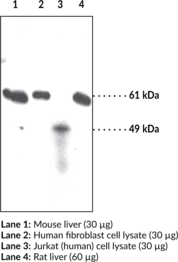Description
The toll-like receptors (TLRs) in mammals comprise a family of transmembrane proteins characterized by multiple copies of leucine rich repeats in the extracellular domain and an interleukin-1 (IL-1) receptor motif in the cytoplasmic domain. Like their counterparts in Drosophila, TLRs signal through adaptor molecules.{17463} The TLR family is a phylogenetically conserved mediator of innate immunity that is essential for microbial recognition.{17464} Most mammalian species have between ten and fifteen types of TLRs. Ten functional TLRs (TLR1-10) have been identified in human. Humans also encode a TLR11 gene but it contains several stop codons and protein is not expressed. However, mouse and rat TLR11 are functional, and it is thought that human TLR11 function was lost during evolution. Historically speaking, TLR expression has been most extensively studied in the immune system. Overall, TLRs are highly expressed in immune competent cells, including macrophages, dendritic cells, neutrophils, mucosal epithelial cells and dermal endothelial cells. However, TLRs have also been identified in many other cell types and anatomical tissue locations where they are expressed either constitutively or induced during infection. Stimulation of the NF-κB signaling pathway by TLR7 suggests that it plays a role in immune response.
Synonyms: TLR7
Immunogen: synthetic peptide from human TLR7 within the region of amino acids 706-728
Formulation: 100 µg of protein G-purified IgG in 200 µl PBS containing 0.05% BSA and 0.05% sodium azide
Isotype:
Applications: WB, FC (intracellular and cell surface), IHC (frozen and paraffin), ICC, and IP
Origin: Animal/Rabbit
Stability: 365 days
Application|Flow Cytometry||Application|Immunocytochemistry||Application|Immunohistochemistry||Application|Immunoprecipitation||Application|Western Blot||Product Type|Antibodies|Polyclonal Antibodies||Research Area|Cell Biology|Cell Signaling|NF-κB Signaling||Research Area|Epigenetics, Transcription, & Translation|Transcription Factors||Research Area|Immunology & Inflammation|Innate Immunity|Pattern Recognition


